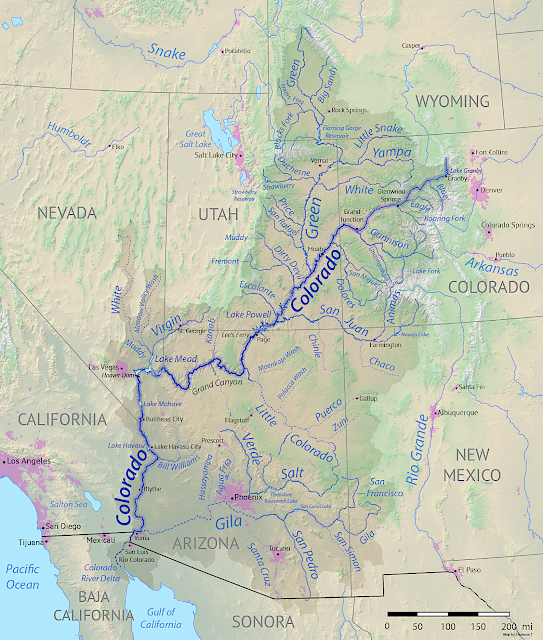Water in the West
You've read in the national news recently that the Colorado River no longer has enough water to allocate to all the states that have a right to it.
 |
| The Colorado River in the wild |
Lake Powell and Lake Mead reservoirs, which are fed by the Colorado, are at critically low levels, about 28% of their capacity and expected to fall lower. There isn't enough water to send to everyone under the water compact that 7 states and Mexico have lived under for the past 100 years. There soon may not be enough water at the dams to produce electricity.
New Mexico is one of the states that gets Colorado River water, but not directly and not much. Through a complex network of diversions and tunnels a small portion of the San Juan River, a tributary of the Colorado, is diverted into the Chama River, which feeds the Rio Grande. New Mexico supplements all its other water sources with water from the Rio Grande.
 |
| A complex series of tunnels, dams and diversions moves water from the Colorado to the Rio Grande |
We are part of the "upper Colorado basin" states in the water compact: New Mexico, Utah, Colorado and Wyoming. The upper basin has made water reductions in the past and should have minimal cuts now.
It's the "lower basin" states -- Arizona, Nevada, California, and the nation of Mexico that are now facing difficult cuts in the water they will get for their populations and agriculture.
 |
| The Rio Grande is nowhere near the Colorado River or even the San Juan but diversion tunnels move water eastward from the basin |
But the whole system is at odds with itself. Agriculture uses 70% of the water but city populations in Las Vegas and Phoenix have been relentlessly growing. The water shortage pits farmers and food producers against cities, upper basin users against lower basin users, states against states, native tribes and even another country against all. So far no one can agree on how much to cut or who should bear the bigger impact.
Faced with the states' complete inability to decide what to do, the Federal Bureau of Reclamation is making mandatory cuts this month.
New Mexico's allocation is so small: it was only 5.6% of all the water in both Colorado basins when the pact was first signed, and the upper basin states already made cuts. New Mexico has been getting only half its Colorado River allocation already, getting by with other sources, while the lower basin states have been getting all of their allocation under the river compact all along. Reducing what little we get now won't have much impact overall.
 |
| Colorado River near Palisade, Co, where my favorite peach vendor grows his orchards |
In a letter to the Bureau of Reclamation this summer, the four upper basin states claim that the problem is a lower basin issue and cuts must be made by those states exclusively. You can see where this is going.
It's a mess for all users of the Colorado River. Too little water, too many farms growing food, too many urban dwellers and suburban lawn waterers, competing historic sovereignties among pueblos, states and countries. And too little snowpack in the mountains.
An impossible task to decide what percentage of nothing is fair.
Comments